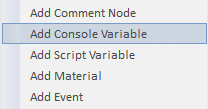For this example, we will add some console commands to the Track View sequence created in the Creating a new Track View sequence and Animating a camera in Track View sections of this chapter. These two sections must be completed before going forward with the following example:
- You should have the
my_first_cutscenecutscene open in Track View and your view set to that of the camera. - Right-click on the parent node of
my_first_cutsceneand select Add Console Variable as shown in the following screenshot:
You will then be asked to name this Console Variable (CVAR).
- For this example, set the name to
e_TimeofDaySpeed. You will see it added as a track to the parent node of the sequence. - Next, create a key frame on the
e_TimeofDaySpeedtrack. Set the value of this key frame to0.5, as shown in the following screenshot:What this will now do is force a command to the console, in this case setting the time of the playback speed to 0.50.

- In this case you can use the setup performed earlier by creating a Flow Graph and adding an Input:Key node to trigger the sequence quickly.
- Trigger the flythrough sequence and notice that the time of day in the level now plays according to the value set in Track View.
Setting CVARs can sometimes be an easy way of achieving some quick effects and changes. Some examples of this are disabling all LODs for marketing videos, or changing rendering effects. In any case, it's valuable to leverage the connection between events happening within a track sequence and the engines console.
